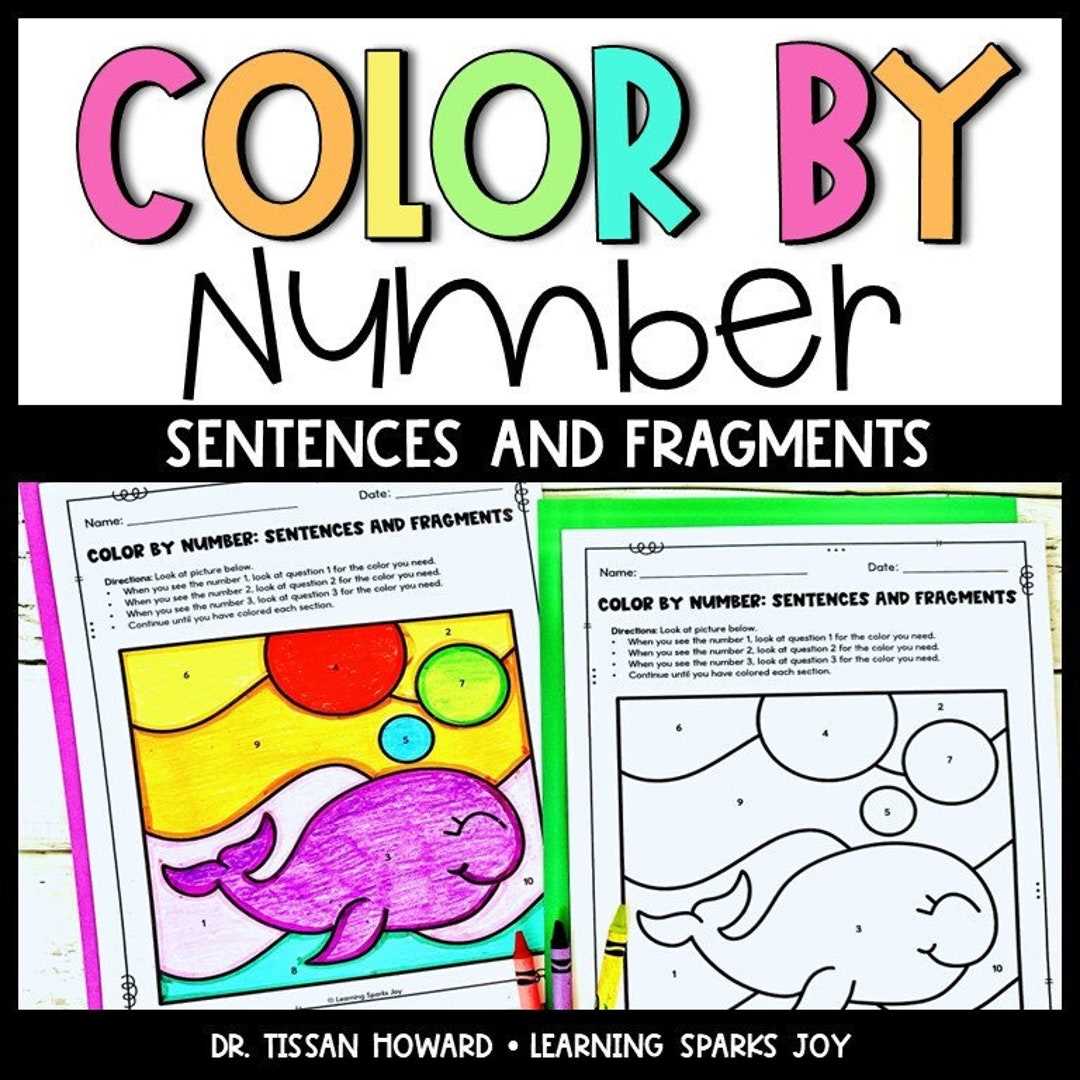
Mastering the art of crafting complete thoughts is essential for clear and effective communication. Many individuals struggle with constructing coherent statements, often leaving parts of their ideas incomplete. These gaps in expression can confuse readers and disrupt the flow of writing. Understanding how to address these issues is key to improving both grammar and overall clarity in written work.
Identifying incomplete expressions and learning how to fix them is a valuable skill for anyone looking to enhance their writing. Whether you’re working on a simple sentence or complex narrative, knowing how to spot and correct missing elements helps maintain the integrity of your communication. It’s a fundamental aspect of grammar that ensures ideas are expressed fully and cohesively.
By practicing exercises that target these common errors, you can strengthen your writing abilities and gain confidence in your skills. With time, correcting incomplete thoughts becomes second nature, leading to more polished and professional writing.
Sentence Fragments and Their Impact
Incomplete thoughts in writing can greatly hinder communication and understanding. These gaps often leave the reader with an unclear message or force them to make assumptions about what the writer intended to convey. Whether in formal documents or casual writing, addressing these issues is crucial for ensuring that the text is fully understood and effectively communicates its point.
When portions of a thought are left unfinished, the flow of the text is disrupted. This can confuse the reader and create ambiguity. It becomes especially problematic in professional or academic settings where clarity and precision are paramount. Writers must be able to deliver their ideas in a way that leaves no room for misinterpretation.
Effects on Reader Engagement
Incomplete expressions can significantly impact how engaged a reader is with the material. If a reader encounters broken or unclear ideas, they may lose interest or have to re-read sections multiple times. This interrupts the overall reading experience and reduces the effectiveness of the communication. Keeping the reader’s attention requires coherent and well-structured writing.
Strategies for Fixing Incomplete Ideas
Correcting incomplete ideas involves understanding the components that are missing and taking the necessary steps to complete the thought. This can be done by adding supporting details, ensuring that verbs and subjects are aligned, or restructuring phrases to provide clarity. A quick revision and editing process can often resolve these issues and strengthen the overall quality of the writing.
| Issue | Impact | Solution |
|---|---|---|
| Unfinished thoughts | Leads to confusion and ambiguity | Complete the idea with necessary details |
| Lack of clarity | Disrupts the flow and engagement | Ensure complete structure and supporting elements |
| Missing subject or verb | Incomprehensible or vague message | Check for missing key components |
Understanding Sentence Fragments in Grammar
In written communication, it is essential for each thought to be expressed completely to avoid confusion. When parts of a statement are left incomplete, it can affect the clarity of the message and make it difficult for the reader to understand the intended meaning. These incomplete expressions can arise from various structural issues in a sentence and can significantly impact the flow of writing.
To grasp the concept of incomplete statements, it’s important to recognize the common causes and structures that contribute to these issues. Understanding where these gaps occur in writing can help improve overall clarity and grammatical accuracy.
- Missing subjects or verbs – The absence of key components such as the subject or verb can leave a statement hanging, making it incomplete.
- Dependent clauses – These are often mistaken for complete statements when, in reality, they need to be paired with an independent clause to make sense.
- Incomplete thoughts – Sometimes, a sentence may start with an idea but fails to complete it, leaving the reader unsure of the point being made.
To avoid these issues, writers must ensure that their ideas are fully developed and well-supported with all necessary parts of speech. This helps to maintain the structure and readability of the text, making it easier for the reader to follow and understand.
- Check for missing parts: Always verify that the subject, verb, and other components are present in the statement.
- Complete dependent clauses: Ensure that dependent clauses are connected to independent clauses to form a full thought.
- Read aloud: Hearing the sentence can often highlight missing elements and improve clarity.
Common Types of Sentence Fragments
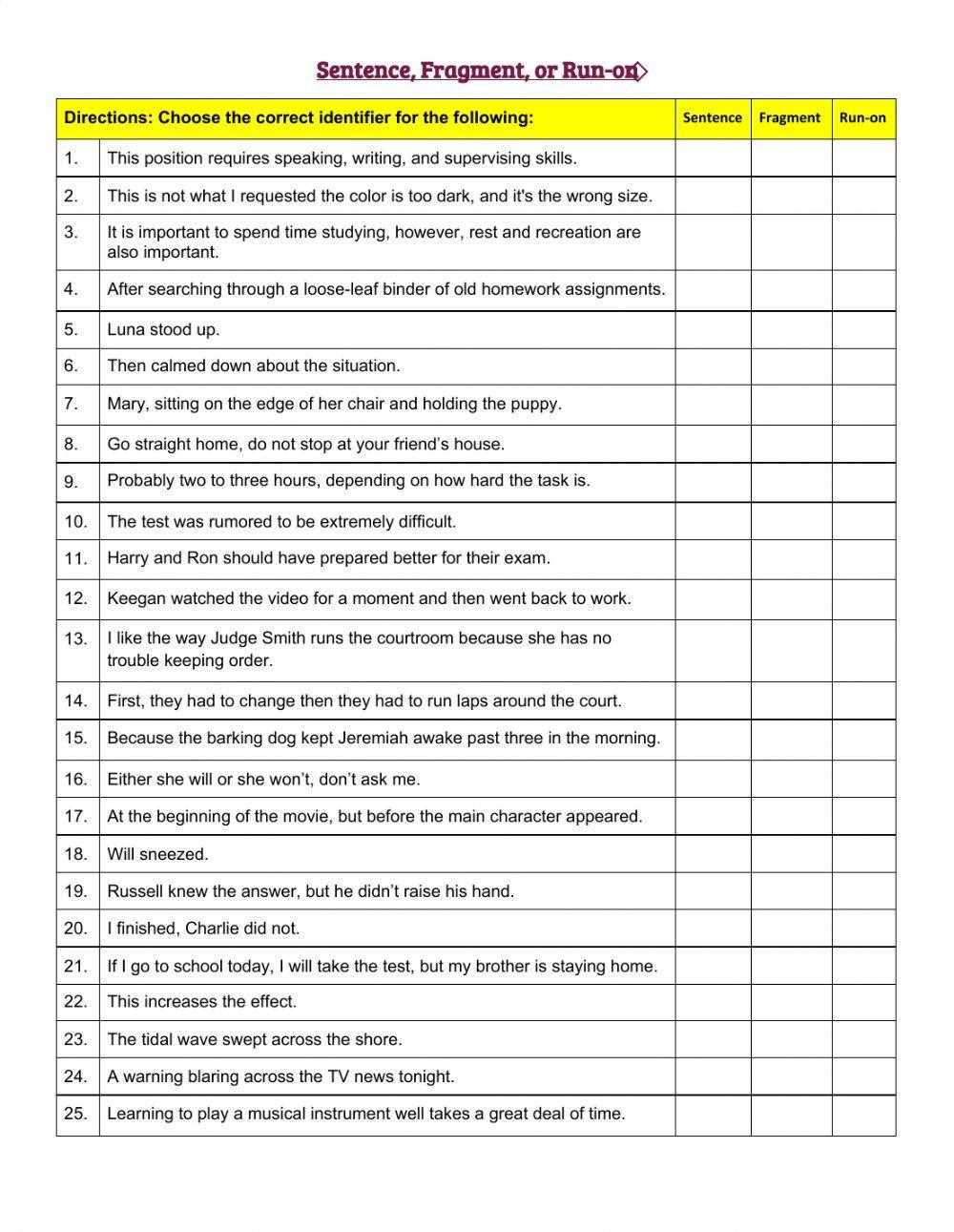
There are several common ways that incomplete expressions can appear in writing. These issues often arise from missing parts of the sentence, leaving the reader with an unclear or disconnected idea. By recognizing the various types of incomplete thoughts, writers can more easily identify and correct these errors in their work.
Incomplete Ideas
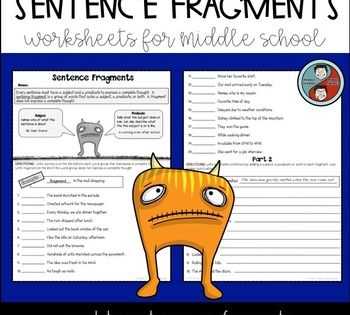
One of the most frequent causes of unclear statements is when the writer begins an idea but fails to finish it. This leaves the reader unsure of the point being made, creating confusion. These incomplete thoughts can occur in various places within a sentence, often at the beginning or end, making the overall meaning unclear.
Dependent Clauses Left Alone
Another common type of incomplete expression happens when dependent clauses are not attached to an independent clause. Dependent clauses rely on independent clauses to complete their meaning, and without this connection, the statement is left hanging. This type of error can often be seen in phrases that start with words like “although,” “because,” or “while.”
| Type of Error | Cause | Example |
|---|---|---|
| Incomplete Idea | Thought starts but doesn’t finish | Running late for the meeting |
| Dependent Clause | Clause left without an independent clause | Because it was raining heavily |
| Missing Subject | Absence of the subject in the statement | Quickly ran down the street |
Why Sentence Fragments Happen
Incomplete thoughts often occur in writing when key parts of the idea are missing or improperly connected. These gaps in communication can result from a variety of factors, including misunderstandings of grammar rules, rushed writing, or even simple oversight. Understanding the causes of these issues is the first step in preventing them and ensuring clear, effective communication.
Common Causes of Incomplete Ideas
- Rushed Writing: When writing quickly, it’s easy to leave out important details or fail to complete an idea.
- Punctuation Mistakes: Incorrect punctuation can cause confusion, leaving parts of a thought isolated.
- Lack of Knowledge: Misunderstanding sentence structure or grammar rules can lead to missing components, like the subject or verb.
- Overly Complex Ideas: Trying to express complex thoughts without proper support can lead to unfinished statements.
How Poor Grammar Understanding Contributes
- Dependent Clauses: These clauses need to be paired with an independent clause but are sometimes left on their own, creating confusion.
- Incomplete Phrases: A phrase that begins but does not complete the thought can result in an incomplete expression.
- Failure to Connect Ideas: Writers sometimes fail to properly link ideas together, leaving gaps between them.
How to Identify Sentence Fragments
Recognizing incomplete thoughts in writing is essential for improving clarity and coherence. Identifying these issues requires careful attention to sentence structure and understanding the essential components that make up a complete idea. By focusing on key grammatical elements, it’s possible to pinpoint where a statement falls short and make the necessary corrections.
The most effective way to identify incomplete expressions is to check whether the statement contains all the required parts: a subject, a verb, and a complete idea. If any of these are missing or improperly connected, the message may not be fully conveyed, leaving the reader confused.
- Check for missing subjects: If the subject is unclear or absent, the sentence may be incomplete.
- Look for missing verbs: Without a verb, the statement cannot express a full thought or action.
- Assess the connection: Ensure that the statement forms a complete idea and does not rely on additional context.
- Evaluate punctuation: Improper punctuation can isolate parts of a thought, leading to an unclear expression.
By practicing these steps, writers can quickly identify and correct incomplete thoughts, leading to more polished and effective writing.
Correcting Sentence Fragments in Writing
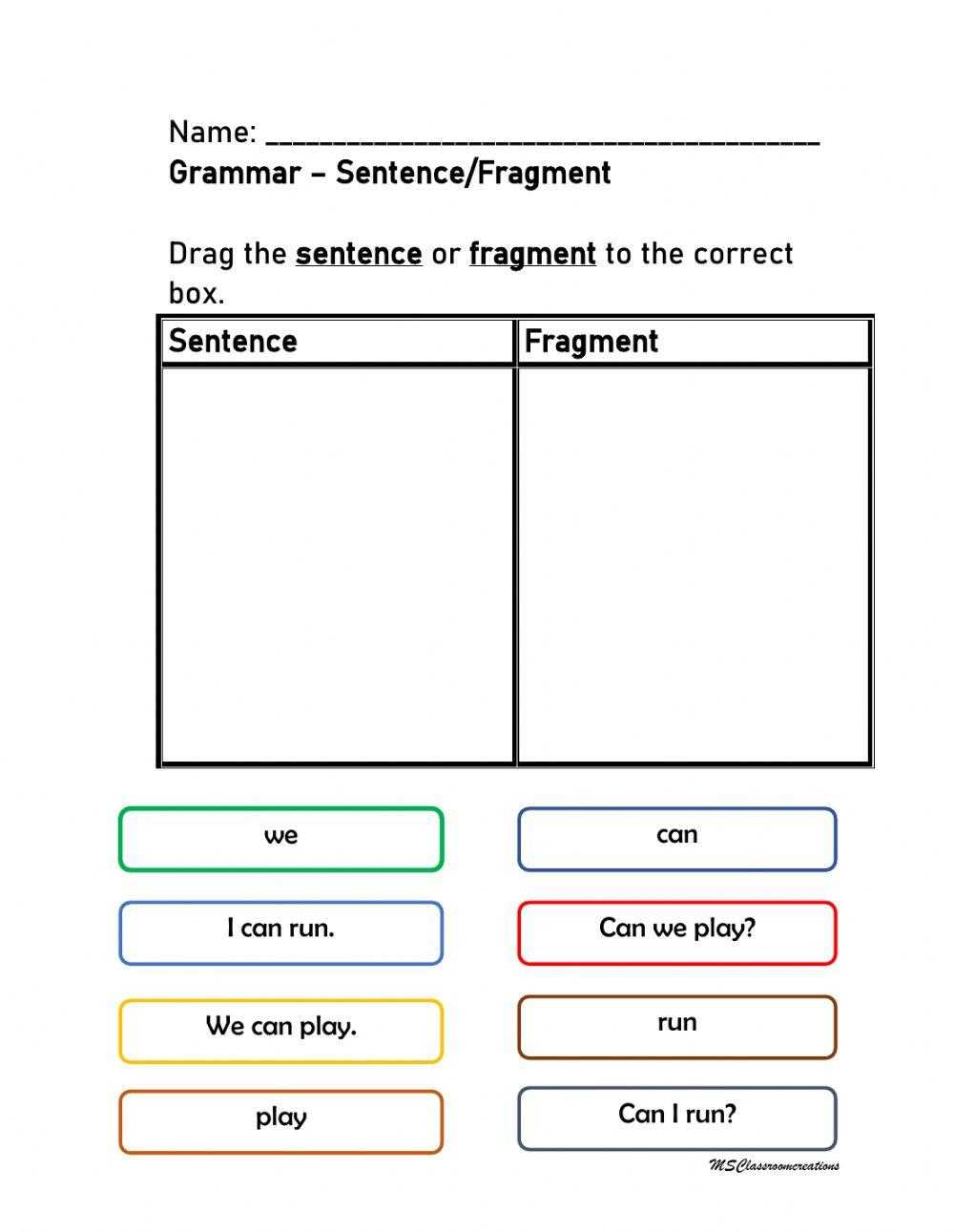
Fixing incomplete thoughts in writing is essential for improving clarity and ensuring that ideas are fully communicated. These gaps often occur when key elements like the subject or verb are missing or when parts of a thought are left unconnected. The goal is to restructure these broken pieces to form cohesive and complete ideas.
Strategies for Completing Ideas
The first step in correcting incomplete expressions is identifying which component is missing. Here are a few ways to complete your thoughts:
- Adding the missing subject or verb: Ensure that every statement has a subject and a verb to make it complete.
- Combining ideas: Join related phrases or clauses to create a fuller thought, ensuring both parts are properly connected.
- Using punctuation correctly: Proper punctuation can help clarify the relationship between different parts of a thought and complete the expression.
Examples of Corrections
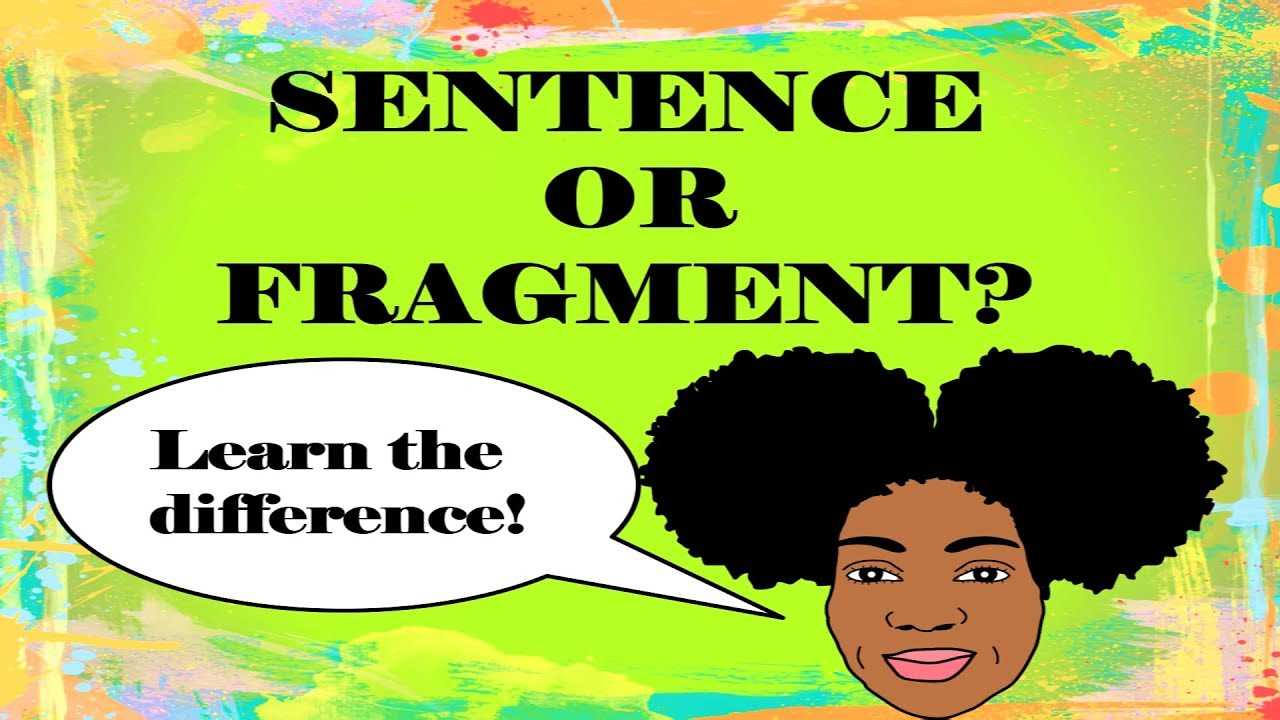
Here are a few examples showing how incomplete ideas can be fixed:
- Original: “Running through the park.”
Corrected: “She was running through the park.” - Original: “Because it was raining.”
Corrected: “She stayed indoors because it was raining.” - Original: “While reading a book.”
Corrected: “He was sitting in the chair while reading a book.”
By using these strategies, writers can easily correct incomplete ideas, leading to clearer and more effective communication.
Common Mistakes in Fragment Worksheets
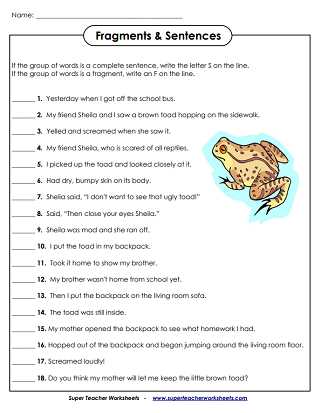
When practicing the identification and correction of incomplete thoughts, certain mistakes are frequently made. These errors often occur due to misunderstandings of grammatical structure, misinterpretation of the rules, or simple oversight. Recognizing and correcting these common pitfalls is crucial for improving overall writing skills.
Many learners tend to overlook subtle issues, such as missing components or improper punctuation, which lead to incomplete ideas. These mistakes can easily be avoided by paying closer attention to the structure of each expression and ensuring that all necessary parts are present and correctly connected.
- Skipping over missing subjects or verbs: A common mistake is failing to notice when an important element like the subject or verb is missing from the statement.
- Incorrectly joining incomplete ideas: Sometimes, learners attempt to combine incomplete thoughts without adding the necessary components to make the expression whole.
- Misplacing punctuation: Using punctuation incorrectly, such as forgetting to add a period or a comma, can make it difficult to identify where one idea ends and another begins.
- Overlooking dependent clauses: Many fail to recognize that dependent clauses need to be connected to independent clauses to create a complete thought.
By being aware of these common mistakes, individuals can improve their understanding of how to form complete, clear, and grammatically correct expressions. This awareness will ultimately lead to better writing and communication skills.
Importance of Sentence Fragments Practice
Consistent practice in identifying and correcting incomplete thoughts is vital for developing strong writing skills. This practice helps writers better understand the structure of complete ideas, ensuring that their expressions are clear, coherent, and grammatically sound. It also enables learners to identify common mistakes early and avoid them in their future writing.
Through repeated exercises, individuals improve their ability to spot gaps or errors in their writing, making it easier to produce polished and professional content. Additionally, this practice strengthens a writer’s overall grammar knowledge and boosts confidence in their ability to communicate effectively.
- Enhanced clarity: Regular practice helps ensure that ideas are fully expressed, leading to clearer communication.
- Stronger grammar skills: By identifying incomplete thoughts, learners reinforce their understanding of sentence structure and proper punctuation.
- Improved writing flow: With more practice, writers learn how to connect ideas smoothly, eliminating awkward pauses or unclear statements.
- Increased confidence: The more one practices, the more confident they become in their ability to create well-structured, complete expressions.
Overall, the importance of practicing these skills cannot be overstated. The more often writers engage with identifying and fixing incomplete thoughts, the better they will be at crafting coherent and effective messages in all forms of communication.
Strategies for Fixing Sentence Fragments
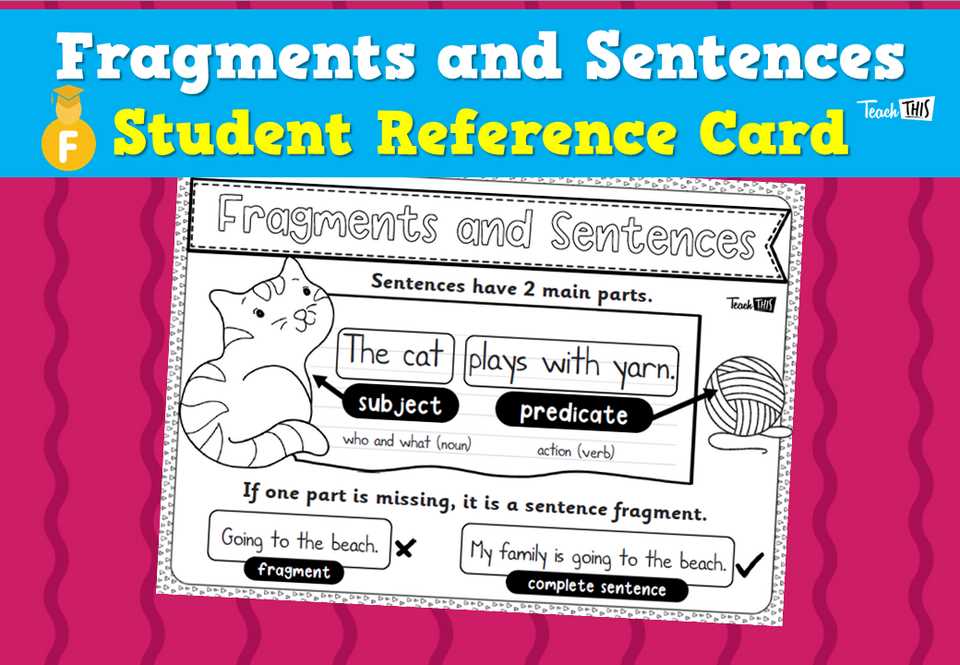
When encountering incomplete thoughts in writing, it’s essential to apply strategies that restore clarity and structure. These techniques ensure that each expression conveys a complete and coherent idea. By understanding the underlying issue and using the right approach, any incomplete statement can be turned into a full, well-formed expression.
There are several methods to address these gaps and improve the overall quality of writing. Below are some practical strategies for correcting these common issues:
- Add Missing Elements: Ensure the expression contains a subject and a verb, which are the core components of any complete thought.
- Join Ideas Together: Combine two or more incomplete thoughts by connecting them with appropriate conjunctions, forming a unified idea.
- Complete Dependent Clauses: When dealing with dependent clauses, make sure they are linked to independent clauses to provide the necessary context and meaning.
- Correct Punctuation: Check punctuation marks carefully. Properly placed commas, periods, or conjunctions can link or end ideas correctly.
- Revise for Clarity: Sometimes, rephrasing the thought or adding additional details can transform a fragmented idea into a complete, clear expression.
By using these strategies, writers can easily fix incomplete thoughts and improve the overall flow and readability of their work, ensuring that their ideas are communicated effectively and accurately.
Examples of Sentence Fragments and Fixes
Recognizing and correcting incomplete thoughts is an important skill for writers. These gaps often result from missing key elements or improper structure, leading to unclear or confusing ideas. Below are some common examples of such incomplete expressions and the corrections needed to make them complete and coherent.
- Example 1: “After the meeting ended.”
Fix: “After the meeting ended, everyone went home.” - Example 2: “Because he was tired.”
Fix: “He went to bed early because he was tired.” - Example 3: “While walking to the store.”
Fix: “She saw a dog while walking to the store.” - Example 4: “The rain pouring down.”
Fix: “The rain was pouring down, causing delays on the roads.” - Example 5: “Since I didn’t hear the bell.”
Fix: “I missed the class since I didn’t hear the bell.”
These examples demonstrate how minor adjustments, such as adding necessary details or linking ideas, can transform incomplete thoughts into fully formed expressions that convey clear meaning.
How to Avoid Sentence Fragments
Preventing incomplete thoughts in writing requires a careful approach to constructing ideas. By understanding the core elements that make a complete expression, writers can ensure their work remains clear and coherent. A proactive approach to sentence structure and punctuation can significantly reduce the chances of encountering these issues.
Here are some practical tips to help avoid incomplete ideas:
- Check for missing components: Every thought should contain at least a subject and a verb. Make sure both are present in every statement.
- Ensure complete ideas: Avoid starting expressions with dependent clauses unless they are attached to independent clauses, creating a complete thought.
- Use proper punctuation: Proper punctuation helps separate and connect ideas correctly. Ensure commas, periods, and conjunctions are used appropriately.
- Review before submitting: Always read over your writing to identify potential gaps or incomplete thoughts that may have been overlooked during the drafting process.
- Practice writing with structure: Regularly practice constructing sentences with clear, defined structures. This helps improve awareness and reduces the likelihood of errors.
By following these strategies, writers can minimize the occurrence of incomplete ideas and create more effective, polished writing.
Sentence Fragments vs Complete Sentences
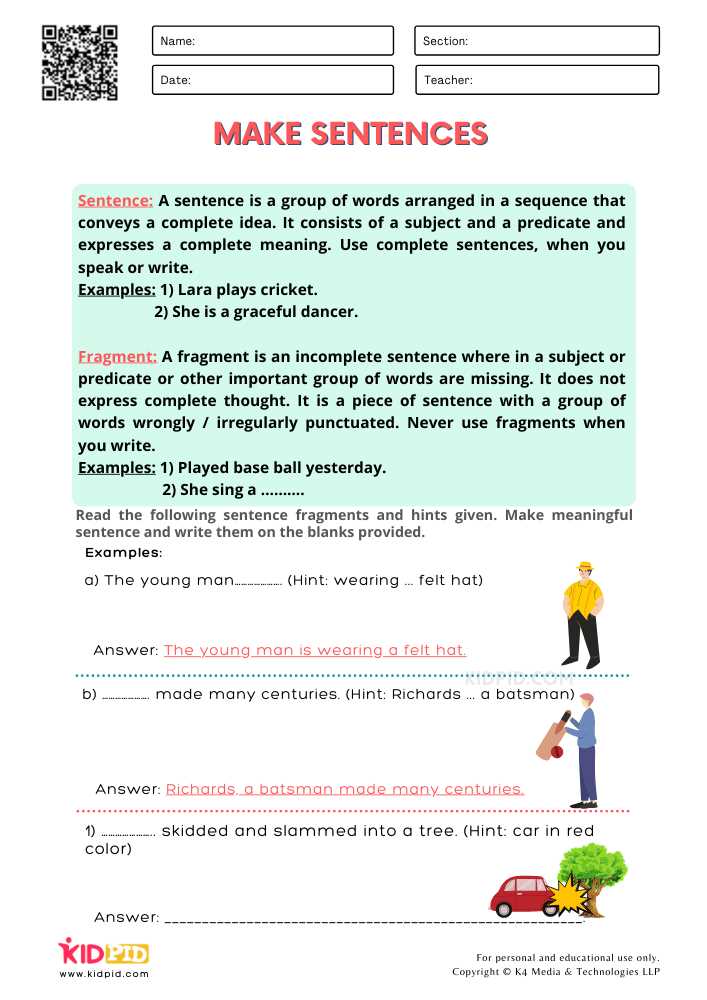
Understanding the difference between incomplete thoughts and fully expressed ideas is crucial for effective communication. While both are common in writing, complete expressions are essential for clarity and coherence, while missing elements can cause confusion or ambiguity. Recognizing how to distinguish between them helps improve overall writing quality.
Here are some key differences between incomplete and complete expressions:
- Incomplete Ideas: These lack essential elements, such as a subject, verb, or both. They may leave the reader wondering about the rest of the thought.
- Complete Thoughts: A complete expression includes both a subject and a verb, forming a self-contained idea that conveys a clear message.
- Dependence: Incomplete ideas often rely on additional information or context to make sense, while complete ideas stand alone.
- Clarity: Complete thoughts are easier to understand, as they provide a full explanation or message, whereas incomplete ideas can cause confusion.
By focusing on ensuring each thought is fully formed and includes all necessary components, writers can avoid common issues that arise from incomplete ideas and improve the overall impact of their work.
Worksheet Tips for Sentence Fragment Exercises
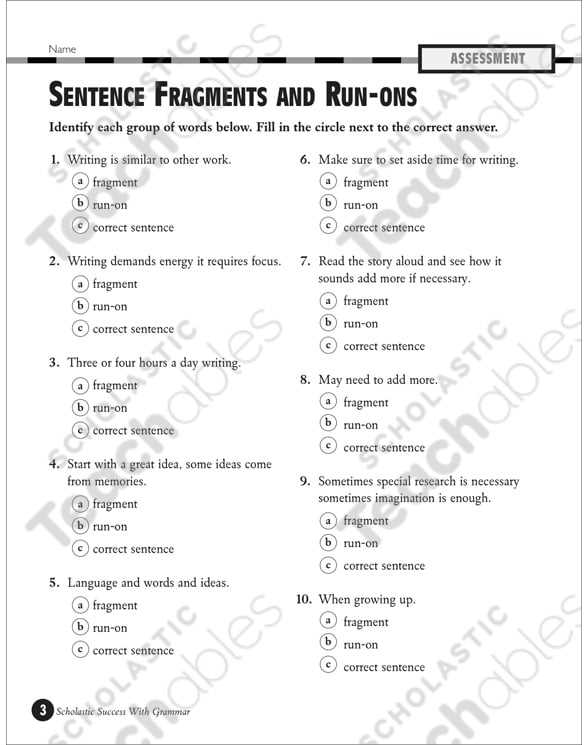
Practicing writing and editing incomplete ideas can significantly enhance writing skills. By focusing on recognizing and fixing gaps in thoughts, learners can improve both their clarity and overall writing coherence. These exercises are designed to help identify where key components are missing and offer strategies for correction.
Here are some helpful tips for tackling these exercises effectively:
- Read each example carefully: Before making any corrections, ensure you fully understand the context of the incomplete thought and its intended message.
- Look for missing elements: Check if the expression has both a subject and a verb. Incomplete thoughts often lack one or both of these basic components.
- Use punctuation effectively: Punctuation marks are crucial for organizing ideas and identifying where thoughts may need to be connected or separated.
- Practice combining ideas: If a thought seems incomplete, practice joining it with another related idea to form a complete statement.
- Check for clarity: Ensure that once corrections are made, the expression is clear and communicates a full message to the reader.
Techniques for Successful Practice
By using these tips and practicing regularly, learners will develop a stronger ability to identify and fix incomplete thoughts. Consistent practice in a variety of contexts will lead to more confident and effective writing.
Improving Grammar Through Fragment Practice
Practicing incomplete thoughts is an effective way to strengthen overall grammar skills. By identifying and correcting missing elements in ideas, learners can gain a better understanding of how to structure clear and complete expressions. This process sharpens both writing and editing abilities, ultimately leading to more polished communication.
Here are several ways this practice can improve grammatical skills:
- Enhancing sentence structure awareness: Regular practice helps recognize how different components–such as subjects, verbs, and modifiers–come together to form coherent ideas.
- Building better punctuation skills: By focusing on where punctuation is needed to connect or separate thoughts, learners improve their understanding of how to use punctuation correctly.
- Developing clearer expression: As learners work through correcting incomplete ideas, they develop a stronger ability to express themselves clearly and effectively in writing.
- Reducing common grammar mistakes: This type of practice helps avoid common errors, such as run-on thoughts or incomplete clauses, which can undermine the quality of writing.
Consistency Leads to Improvement
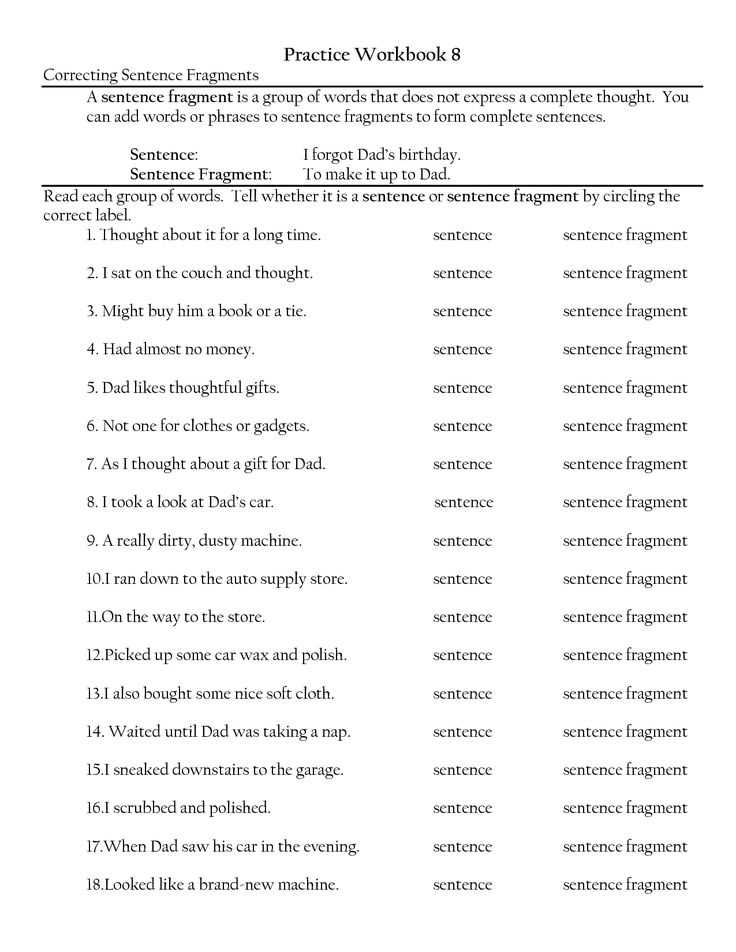
By consistently engaging with exercises that focus on incomplete expressions, learners can develop a more instinctive understanding of grammar rules. This practice fosters a deeper level of proficiency, enabling individuals to write with greater confidence and precision.
How Sentence Fragments Affect Clarity
Incomplete thoughts can significantly hinder the clarity of written communication. When an idea is left unfinished or lacks necessary components, it can confuse the reader and disrupt the flow of information. Clear, well-structured expressions are essential for ensuring that the message is conveyed effectively, without ambiguity.
Here are some ways in which missing elements impact understanding:
- Loss of meaning: Without key components, an idea may be unclear or seem disconnected, making it harder for the reader to understand the intended message.
- Interrupted flow: When incomplete thoughts appear in writing, they break the natural flow of information, forcing readers to pause and re-interpret the content.
- Reduced professionalism: Writing that includes unfinished ideas can come across as unpolished or careless, undermining the effectiveness of the communication.
- Confusion in context: Incomplete thoughts can lead to misunderstandings, as the reader may not have enough information to grasp the full context of the discussion.
For clear and concise communication, it’s important to ensure that each thought is fully developed and structured properly. When components are missing, the message may become muddled, leaving the reader unsure about the point being made.
Using Punctuation to Fix Sentence Fragments
Punctuation plays a crucial role in transforming incomplete ideas into coherent thoughts. Properly placed punctuation marks can provide structure and clarify meaning, turning disjointed or unfinished phrases into complete statements. Correct punctuation ensures that every part of a message is understood as intended, preventing confusion.
When working to fix incomplete ideas, here are some common punctuation techniques that can help:
| Punctuation Mark | How it Helps |
|---|---|
| Period (.) | Ends a thought and helps separate incomplete ideas, making them distinct and clear. |
| Comma (,) | Joins related thoughts and helps create smoother transitions between parts of a sentence. |
| Semicolon (;) | Links closely related ideas without needing a conjunction, providing balance and flow. |
| Colon (:) | Introduces a list or explanation, completing an idea and providing clarity. |
By carefully applying punctuation marks, writers can ensure that their ideas are presented clearly and logically, avoiding confusion and improving the overall flow of their writing. Well-placed punctuation not only fixes incomplete thoughts but also strengthens the overall structure and readability of the text.